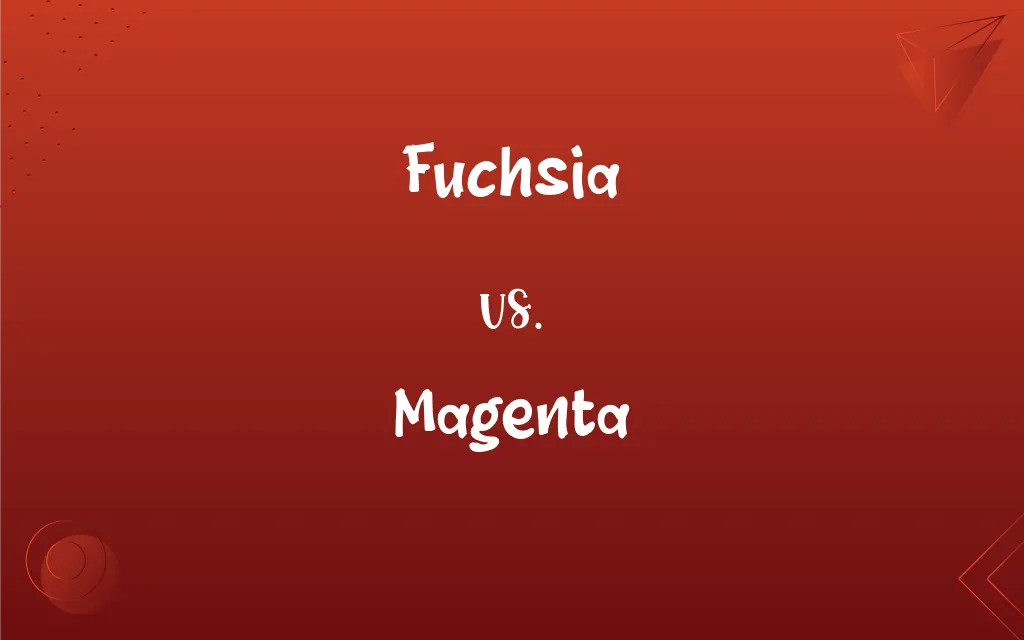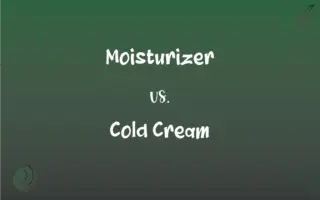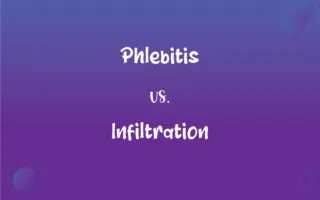Fuchsia vs. Magenta: What's the Difference?
Edited by Aimie Carlson || By Harlon Moss || Published on March 3, 2024
Fuchsia is a vivid purplish-red color, often associated with the flowering plant of the same name, while magenta is a deep purplish-pink color, originally a dye made from coal tar.

Key Differences
Fuchsia, named after the fuchsia plant, has a natural, floral origin. Magenta was named in the 19th century after the Battle of Magenta, and its synthetic dye origin marks a significant development in industrial chemistry.
Fuchsia is closer to purple on the color spectrum, with a deep pinkish hue. Magenta, one of the primary colors in the CMYK color model, is a blend of red and blue, leaning more towards pink.
Fuchsia is often associated with femininity and vibrancy in Western cultures. Magenta, due to its synthetic origin, is sometimes linked to artificiality and is used extensively in printing and design.
Both colors have various shades, fuchsia tends to vary from light to dark purplish-pink. Magenta can range from a soft pink to a deep, almost neon pink-purple.
Fuchsia is a popular choice in floral and feminine designs and fashion items. Magenta is widely used in graphic design, highlighting its synthetic and vibrant nature.
ADVERTISEMENT
Comparison Chart
Origin
Named after the fuchsia plant
Named after the Battle of Magenta
Color Spectrum
Closer to purple
A primary color in CMYK, blend of red and blue
Cultural Association
Femininity, nature
Artificiality, modernity
Variations
Light to dark purplish-pink
Soft to deep neon pink-purple
Common Use
Floral designs, fashion
Printing, graphic design
ADVERTISEMENT
Fuchsia and Magenta Definitions
Fuchsia
Fuchsia is used to describe vivid and bold color schemes.
She painted the accent wall a vibrant fuchsia.
Magenta
Magenta is a deep purplish-pink color.
The sunset sky turned a beautiful shade of magenta.
Fuchsia
Fuchsia can refer to a flowering plant with vivid pinkish-purple petals.
Her garden was full of blooming fuchsia plants.
Magenta
Magenta is used in design to create a sense of vibrancy.
The artist used magenta to add warmth to the painting.
Fuchsia
Fuchsia is a bright purplish-red color.
The bridesmaids wore dresses in a stunning shade of fuchsia.
Magenta
Magenta is often associated with creativity and innovation.
The graphic design featured magenta to evoke a modern feel.
Fuchsia
In fashion, fuchsia is a popular color for statement pieces.
His tie was a bold fuchsia, adding a pop of color to his suit.
Magenta
In printing, magenta is one of the four primary ink colors.
The printer ran out of magenta ink, affecting the color balance.
Fuchsia
Fuchsia is often associated with playful and energetic designs.
The party decorations were predominantly fuchsia and gold.
Magenta
Magenta can refer to synthetic dyes and pigments.
The fabric was dyed with a rich magenta color.
Fuchsia
Any of various tropical shrubs or trees of the genus Fuchsia, widely cultivated for their showy, drooping, purplish, reddish, or white flowers.
Magenta
See fuchsin.
Fuchsia
A strong, vivid purplish red.
Magenta
A purplish red, one of the subtractive primary colors.
Fuchsia
A popular garden plant, of the genus Fuchsia, of the Onagraceae family, shrubs with red, pink or purple flowers.
Magenta
A vibrant light purple, purplish-red, reddish-purple, or pinkish purple colour obtained by mixing red and blue light (thus a secondary colour), but primary in the CMYK colour system used in printing.
Fuchsia
A purplish-red colour, the color of fuchsin, an aniline dye.
Magenta
Having the colour of fuchsia, fuchsine, light purple.
Fuchsia
Having a purplish-red colour.
Magenta
An aniline dye obtained as an amorphous substance having a green bronze surface color, which dissolves to a shade of red; also, the color; - so called from Magenta, in Italy, in allusion to the battle fought there about the time the dye was discovered. Called also fuchsin, fuchsine, roseïne, etc.
Fuchsia
A genus of flowering plants having elegant drooping flowers, with four sepals, four petals, eight stamens, and a single pistil. They are natives of Mexico and South America. Double-flowered varieties are now common in cultivation.
Magenta
The purplish-red color of magenta.
Fuchsia
A plant belonging to the genus Fuschia.
Magenta
A dark purple-red; the dye was discovered in 1859, the year of the battle of Magenta
Fuchsia
Any of various tropical shrubs widely cultivated for their showy drooping purplish or reddish or white flowers; Central and South America and New Zealand and Tahiti
Magenta
A battle in 1859 in which the French and Sardinian forces under Napoleon III defeated the Austrians under Francis Joseph I
Fuchsia
A dark purple-red; the dye was discovered in 1859, the year of the battle of Magenta
Magenta
Deep purplish red
FAQs
What is the color fuchsia?
A vivid purplish-red color, often associated with the fuchsia plant.
What is magenta?
A deep purplish-pink color, originally a synthetic dye.
Can fuchsia vary in shade?
Yes, from light pinkish-purple to deep purplish-red.
How is fuchsia used in design?
Often in floral, feminine, and vibrant designs.
Is fuchsia popular in fashion?
Yes, especially for bold and statement pieces.
What does fuchsia symbolize?
Playfulness, energy, and femininity.
What's magenta's role in printing?
It's a primary color in the CMYK color model.
Which is brighter, fuchsia or magenta?
Subjective, but magenta is often seen as more vibrant.
Are fuchsia and magenta the same?
No, they are distinct shades of purplish-pink.
What does magenta represent?
Artificiality, vibrancy, and modernity.
How is magenta used in graphic design?
To create vibrancy and a modern feel.
What flowers are fuchsia colored?
The fuchsia plant and other similarly colored flowers.
Is magenta a natural color?
No, it was originally a synthetic dye.
Is magenta easy to print?
Yes, it's a standard color in printing.
Does magenta have historical significance?
Named after an 1859 battle, marking its synthetic dye origins.
Is fuchsia suitable for all design styles?
Best for vibrant and energetic themes.
Does fuchsia have a cultural significance?
Yes, often linked to femininity and nature.
What's unique about magenta in art?
Its vibrancy and ability to evoke warmth.
Can fuchsia be a calming color?
It's more energetic than calming.
Can magenta be mixed with other colors effectively?
Yes, it pairs well with various colors for a modern palette.
About Author
Written by
Harlon MossHarlon is a seasoned quality moderator and accomplished content writer for Difference Wiki. An alumnus of the prestigious University of California, he earned his degree in Computer Science. Leveraging his academic background, Harlon brings a meticulous and informed perspective to his work, ensuring content accuracy and excellence.
Edited by
Aimie CarlsonAimie Carlson, holding a master's degree in English literature, is a fervent English language enthusiast. She lends her writing talents to Difference Wiki, a prominent website that specializes in comparisons, offering readers insightful analyses that both captivate and inform.







































































